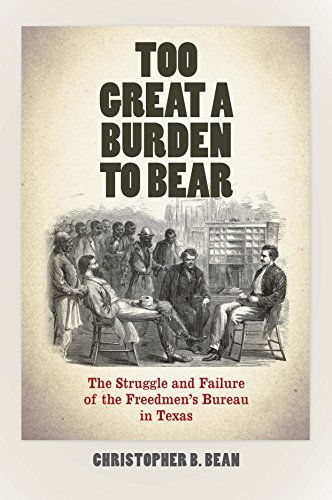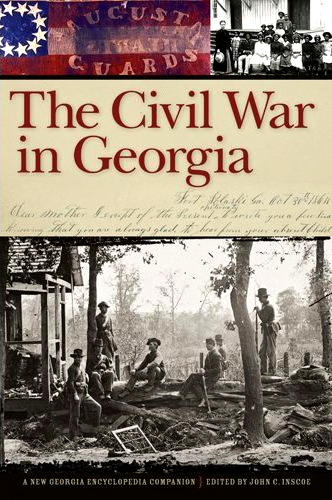Too Great a Burden to Bear: The Struggle and Failure of the Freedmen’s Bureau in Texas by Christopher B. Bean. Fordham University Press, 2016. Paper, ISBN: 978-0823271764. $40.00.
 With the sesquicentennial of Reconstruction underway, Christopher B. Bean’s Too Great a Burden to Bear is a timely reassessment of one of the most misunderstood agencies at the center of the debate over the meaning of the Civil War. Acknowledging a rich literature defined by W. E. B. Du Bois, Paul Cimbala, LaWanda and John Cox, Barry Crouch, and others, Bean’s well-researched discussion centers on the subassistant commissioners (SACs) who had daily interactions with white and black civilians. The author reveals the subassistant commissioners’ motivations, the obstacles before them, and their firm commitment to facilitating newly freed black Texans’ transition from slavery to citizenship. Moving beyond outright dismissal, Bean argues: “The country asked them to do the unprecedented, and, despite falling short of some expectations (including some of their own), they archived more than many thought possible (3).”
With the sesquicentennial of Reconstruction underway, Christopher B. Bean’s Too Great a Burden to Bear is a timely reassessment of one of the most misunderstood agencies at the center of the debate over the meaning of the Civil War. Acknowledging a rich literature defined by W. E. B. Du Bois, Paul Cimbala, LaWanda and John Cox, Barry Crouch, and others, Bean’s well-researched discussion centers on the subassistant commissioners (SACs) who had daily interactions with white and black civilians. The author reveals the subassistant commissioners’ motivations, the obstacles before them, and their firm commitment to facilitating newly freed black Texans’ transition from slavery to citizenship. Moving beyond outright dismissal, Bean argues: “The country asked them to do the unprecedented, and, despite falling short of some expectations (including some of their own), they archived more than many thought possible (3).”
Bean begins with a detailed demographic understanding of the agents, including their socioeconomic backgrounds, race, education, previous military service, motivations for becoming agents, and average tenure in the agency. He deftly uses employment applications to demonstrate that agents joined the bureau for a variety of reasons: wages, patriotism, and the opportunity of reconstructing the former Confederate states. The agency chose individuals who were most likely to handle the post-emancipation challenges of “wiping away the last vestiges of slavery and secession (29).” Bean frames subsequent chapters around the SACs’ activities under the four specific assistant commissioners administrations. J. B. Kiddoo receives an extended discussion. His tenure marked the apex of the organization’s expansion of agents and services. This organizational framework allows readers to fully grasp the immensity of subassistant commissioners’ duties for implementing the Reconstruction project.
From the beginning, inefficiency within the bureaucratic infrastructure, a lack of manpower, a lack of clearly defined responsibilities, and a hostile white community posed significant obstacles for the temporary agency designed to facilitate emancipated African Americans’ transition to citizenship and free labor. Throughout, Bean argues against prevailing misconceptions of the Freedmen’s Bureau. For instance, he insists that SACs’ encouragement, as well as enforcement of labor contracts, did not equate with the “return of slavery in another form (41).” Rather, SACs were honest men who strove to secure the interests of white employers and black workers. Fulfillment of white and black Texans’ expectations (or the lack thereof) simultaneously produced disappointment, vehemence, and satisfaction. Yet, SACs still meted out color-blind justice whether in dealing with labor concerns, protecting black Texans’ rights, or overseeing the expansion of a biracial electorate following the Reconstruction Acts of 1867. Moreover, Bean reveals the effects of internal bureaucratic problems and a hostile environment on operations. Agents simply did not last long on account of stress, mistrust of leadership, and violence directed toward them. Interestingly, the SACs’ shared experience encouraged a camaraderie that transcended all issues and even intensified their commitment to the entire Reconstruction project.
Following Kiddoo’s administration, operations waned. On December 31, 1868, General Orders No. 40 ushered in both the official end of non-educational freedmen’s affairs, as well as the intensification of white Texans’ rhetorical and real violence. Joseph J. Reynolds, the last assistant commissioner, strove to end bureau operations with dignity. Much of the agency’s final policies and activities focused on another transition for black Texans: a life without the Freedmen’s Bureau. Even as educational operations continued under a fifth assistant commissioner, the bureau’s demise reflected national attitudes that the agency’s work was complete. White and black Texans had to learn to live together without further federal assistance.
In his conclusion, Bean connects Reconstruction-era efforts with more modern military occupations. This comparison demonstrates how the temporary postbellum agency eventually helped to change some white Texans’ attitudes. By protecting black Texans’ rights, the Freedmen’s Bureau served to define their postwar inclusion into the body politic and citizenship. Ultimately, the failed promises of the Freedmen’s Bureau (inherent to its foundation) “were incapable of being fulfilled. That any were ever promised…is the real tragedy of Reconstruction (181).”
Scholars, graduate students, and general readers alike will appreciate Bean’s nuanced reassessment of the Freedmen’s Bureau. Readers might quibble whether Texas is representative of the federal agency’s operations elsewhere, or question his occasionally oversimplified presentation of white Texans’ opposition toward the agency. Nevertheless, Bean’s inclusion of detailed tables, biographies of key personnel, and appendices is convincing. Texas serves as a great barometer for understanding Freedmen’s Bureau’s non-educational operations, and the massive white resistance against the entire Reconstruction project—making citizens of newly emancipated African Americans.
Hilary Green is Assistant Professor of History in the Department of Gender and Race Studies at the University of Alabama and the author of Educational Reconstruction: African American Schools in the Urban South, 1865-1890 (2016).
